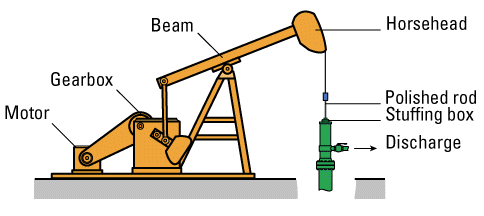
This topic describes the concept of artificial lift. This domain introduction is provided to familiarize the reader with the basic concepts required to understand and use the artificial lift sub-section of the downhole facility model. This is not an exhaustive introduction. References to more complete domain information will be provided.
Artificial lifting methods are used when the pressure from natural reservoir drive decreases to the point where the well stops producing. The most common ways of providing artificial lift use pumps and gas injection.
The most common method of pumping oil in land-based wells is beam pumping. Beam pumping consists of surface and subsurface equipment. The beam-pumping unit sits on the surface and creates an up-and-down motion to a string of rods called sucker rods. The top of the sucker rod string is attached to the front of the pumping unit, usually to a walking beam, and hangs down inside the tubing. At the end of the string, near the bottom of the well, is a sucker rod pump. The walking beam's reciprocating action moves the rod string up and down to operate the pump. In many fields, older wells that have been using beam-pumping units gradually begin producing much more water than oil. In order to recover enough oil to be profitable, tremendous volumes of fluid have to be lifted from the well.

Electric submersible pumps (ESP) have become popular because the rig operator can stack as many pumps as needed in the well. Both the pump motors and the pumps are downhole, submerged in the well fluid on the end of the tubing string. A protector between the pump and motor seals the well fluids away from the motor and buffers the pump from the movement of the motor. A special heavy-duty armored cable supplies electricity to the unit. The main disadvantage of submersible pumps is that they are sensitive to sand and gas.

Hydraulic pumping is similar to beam pumping in that an engine on the surface powers a pump in the hole, but it uses hydraulic energy, or the energy of a flowing liquid, to make the pump work instead of using sucker rods. Because the hydraulic pump does not use sucker rods, it is less complicated to service than the mechanical system, but the pump wears out easily due to erosion. Another advantage is that hydraulic pumps can work in deeper wells than sucker rod pumps.
A hydraulic system actually has two pumps: an ordinary electric or engine-driven pump on the surface to force a liquid, called the power paid, down the hole, and a hydraulic pump at the bottom of the well that the power fluid runs.
One type of hydraulic system recycles crude oil pumped from the reservoir into a settling tank on the surface as the power fluid. Another type is a closed system that uses treated water as the power fluid, which is kept separated from the produced oil.
The term gas lift covers a variety of methods by which a gas is used to increase the production of a well or to restore production to a well that has stopped flowing�a dead well. When a well flows on its own, it may be using a natural form of gas lift-dissolved-gas drive or gas-cap drive.
Natural gas can also be injected into the well to lift the oil artificially on the same principle. The completion crew installs gas-lift valves on the production tubing. The valves allow a gas to be forced into the annulus to pass into the tubing and into the liquid there.
To understand the principle of gas lift, recall that gas is lighter than oil and water. For example, 1 gallon of water weighs a little over 8 pounds, while 1 gallon of natural gas weighs only a fraction of an ounce. When the natural gas enters the liquid in the tubing, the gas makes this liquid column much lighter in weight. Since the liquid column is lighter, it exerts less pressure on the bottom of the well. With the pressure lower at the bottom, the pressure remaining in the reservoir becomes sufficient to push reservoir fluids to the surface through the tubing. Gas may be injected continuously or intermittently, depending on the producing characteristics of the well and the arrangement of the gas-lift equipment.
Gas lift is common when a supply of gas is economical and available and when the amount of petroleum it will lift justifies the expense. Gas lift is especially suitable for offshore use because platform space is limited and gas-lift equipment is largely downhole.
